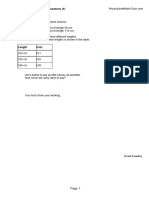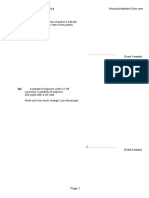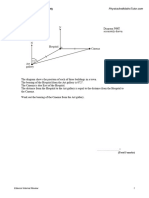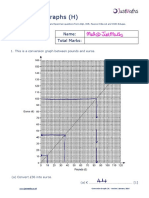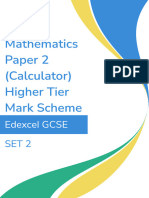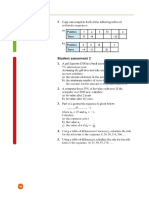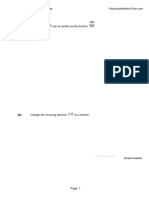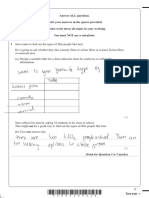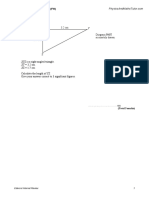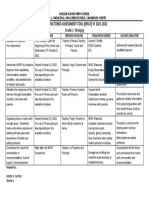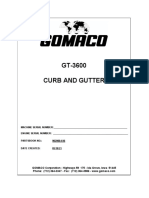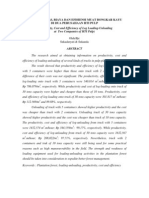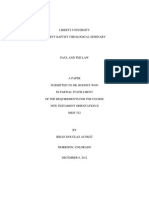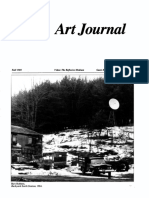Edexcel Maths GCSE - Conversion Graphs (FH) PhysicsAndMathsTutor.
com
Q1.
The conversion graph can be used to change between euros and dollars.
(a) Use this graph to change 30 euros into dollars.
.......................... dollars
(1)
(b) Use this graph to change 90 dollars into euros.
.......................... euros
(1)
Page 1
�Edexcel Maths GCSE - Conversion Graphs (FH) PhysicsAndMathsTutor.com
Bill changes 100 euros to dollars.
(c) Change 100 euros to dollars.
.......................... dollars
(2)
(Total 4 marks)
Q2. You can use this formula to change a temperature C, in °C, to a temperature F, in °F.
F = 1.8C + 32
(a) Use the formula to change 20°C into °F.
......................... °F
(2)
(b) On the grid below, draw a conversion graph that can be used to change between
temperatures in °C and temperatures in °F.
Page 2
�Edexcel Maths GCSE - Conversion Graphs (FH) PhysicsAndMathsTutor.com
(3)
(c) Use your graph to change 100 °F into °C.
......................... °C
(1)
(Total 6 marks)
Page 3
�Edexcel Maths GCSE - Conversion Graphs (FH) PhysicsAndMathsTutor.com
Q3. Sophie’s company pays her 80p for each mile she travels.
The graph can be used to work out how much her company pays her for travel.
Sophie travels 20 miles.
(a) Work out how much her company pays her.
£ .................................
(1)
Sophie’s company paid her £60
(b) Work out the distance Sophie travelled.
Page 4
�Edexcel Maths GCSE - Conversion Graphs (FH) PhysicsAndMathsTutor.com
............................. miles
(2)
(Total 3 marks)
Q4. Barbara goes on holiday to Prague. The currency in Prague is the Koruna (KC).
This graph can be used to convert between £ (pounds) and KC (Koruna).
The exchange rate is £1 = 30 KC.
Barbara bought some things in London.
She saw the same things on sale in Prague.
The table shows the cost in £ (pounds) and the cost in KC (Koruna).
Cost in London Cost in Prague
Page 5
�Edexcel Maths GCSE - Conversion Graphs (FH) PhysicsAndMathsTutor.com
£ (pounds) KC (Koruna)
Item
Headphones £15 450 KC
Suitcase £34 750 KC
Music player £26 810 KC
Barbara thinks the total cost of these things was more in London than in Prague.
Is she correct?
Give a reason for your answer.
You must show all your working.
(Total 5 marks)
Q5. This conversion graph can be used to change between miles and kilometres.
Page 6
�Edexcel Maths GCSE - Conversion Graphs (FH) PhysicsAndMathsTutor.com
(a) Use the graph to change 30 miles to kilometres.
...................................................... kilometres
(1)
(b) Use the graph to change 40 kilometres to miles.
........................................ miles
(1)
(c) Change 100 miles to kilometres.
Page 7
�Edexcel Maths GCSE - Conversion Graphs (FH) PhysicsAndMathsTutor.com
................................. kilometres
(2)
(Total 4 marks)
Q6. This is a graph that can be used to convert between £ (pounds) and € (euros).
Page 8
�Edexcel Maths GCSE - Conversion Graphs (FH) PhysicsAndMathsTutor.com
This is part of a clipping from a newspaper showing the exchange rates for some
countries.
(a) The exchange rate for the euro has been smudged.
Find an estimate for the exchange rate for the euro.
.....................................
(2)
Ali wishes to buy a villa in Spain.
She has a budget of £150 000
In a brochure she sees these three villas.
(b) Which of these three villas can Ali afford to buy?
You must show your working.
.....................................
(3)
(Total 5 marks)
Page 9
�Edexcel Maths GCSE - Conversion Graphs (FH) PhysicsAndMathsTutor.com
Q7. John cleans carpets of different areas.
He uses this graph to work out the cost of cleaning a carpet.
A carpet has an area of 30 m2.
(a) Use the graph to find the cost of cleaning this carpet.
£ ..................................
(1)
It costs £150 to clean another carpet.
(b) Use the graph to find the area of this carpet.
Page 10
�Edexcel Maths GCSE - Conversion Graphs (FH) PhysicsAndMathsTutor.com
.............................. m2
(1)
A rectangular carpet has a length of 8.6 m.
It has a width of 5 m.
(c) Work out the cost of cleaning this carpet.
£ ..................................
(3)
(Total 5 marks)
Q8.
This conversion graph can be used to change between metres and feet.
(a) Use the conversion graph to change 6 metres to feet.
Page 11
�Edexcel Maths GCSE - Conversion Graphs (FH) PhysicsAndMathsTutor.com
..................................... feet
(1)
(b) Use the conversion graph to change 8 feet to metres.
..................................... metres
(1)
Robert jumps 4 metres.
James jumps 12 feet.
(c) (i) Who jumps furthest, Robert or James?
.....................................
(ii) How did you get your answer?
................................................................................................................
................................................................................................................
(2)
(Total 4 marks)
Page 12
�Edexcel Maths GCSE - Conversion Graphs (FH) PhysicsAndMathsTutor.com
M1.
Answer Mark Additional Guidance
(a) 45 1 B1 for 44 – 46
(b) 60 1 B1 cao
(c) 150 2 M1 for a complete method e.g. reading from
graph at 50 euros and doubling
(allow ±1mm tolerance in reading from graph)
A1 for 140 – 160
SC: B2 for 200
Total for Question: 4 marks
M2.
Working Answer Mark Additional Guidance
(a) 68 2
M1 for
A1 cao
(b) Table of values Single line from 3 B3 for correct single straight line from
10 20 30 40 50 (0, 32) to (0, 32) to (50, 122)
50 68 86 104 12 (50, 122)
[B2 for at least 3 points correctly plotted (ft
2
from (a)) and joined with line segments or 3
or
correct points plotted two of which must be
Use y = mx + c the extremes with no joining
With m = , c = 32 or a single line of gradient passing
through (0,32)
B1 for 2 correctly plotted points ft from (a)
or a single line of gradient
or a single line with positive gradient
passing through (0,32)
Page 13
�Edexcel Maths GCSE - Conversion Graphs (FH) PhysicsAndMathsTutor.com
or 2 correct pairs of values, may include
(20,68) from (a) if correct]
(c) 37.8 1 B1 for answer in range 36 - 39
or ft from line drawn (± 2mm)
NB : Whole question needs to be clipped
together
Total for Question: 6 marks
M3.
Working Answer Mark Additional Guidance
(a) 0.80 × 20 16 1 B1 cao
OR
reading from graph at
distance = 20 miles
(b) £20 = 25 miles 75 2 M1 for using £20 = 25 miles oe and
25 × 3 = 75 intention to multiply
OR OR
60 ÷ 0.8 = 75 M1 for 60 ÷ 0.8
OR
M1 for reading from the graph and an
attempt to scale up.
Ie 37×2 or 38×2 or 12×6 or 12.5×6 or 13×6
oe
And
A1 72-78 inclusive
Total for Question: 3 marks
M4.
Page 14
�Edexcel Maths GCSE - Conversion Graphs (FH) PhysicsAndMathsTutor.com
Working Answer Mark Additional Guidance
London: Yes. 5 M1 conversion method (× or ÷ as
£15, £34, £26 (£75) Cheaper in appropriate) or evidence of use of graph
→ 450, 1020, 780 (2250) KC Prague (seen, or implied, by at least lines or
(More in evidence of conversion by marks on
Prague: London) axes) for at least one figure.
450, 750, 810 KC (2010KC) M1 (dep) conversion applied to 3 figures
→ £15, £25, £27 (£67) or totals (converted figures must be
stated, marks on graph insufficient)
£ to KC is × 30; KC to £ is ÷ 30. A1 converted figures shown (all three
individual items or totals converted
correctly; NB: no tolerance on graph)
M1 totalling converted amounts
C1 (dep on at least M1) comparison of
“totals” and correct conclusion
Eg “2250KC” > ”2010KC”, “£75” > ”£67”
so cheaper to buy in Prague.
Total for Question: 5 marks
M5.
Working Answer Mark Additional Guidance
(a) 48 1 B1 for an answer in the range 47.5 to
48.2
(b) 25 1 B1 cao
(c) 32 × 5 155 to 165 2 M1 for complete method reading from
16 × 10 graph then multiplying by a suitable scale
100 × 1.6 factor. Eg 1.6 × 100, 8 × 20, 16 × 10,
32 × 5, 40 × 4, 48 × 3 or valid use of
answer to (a) or (b)
A1 for answer in the range 155 to 165 or
ft on their answers to either (a) or (b)
Total for Question: 4 marks
Page 15
�Edexcel Maths GCSE - Conversion Graphs (FH) PhysicsAndMathsTutor.com
M6.
Working Answer Mark Additional Guidance
(a) £1 = 1.15 2 M1 for reading off one of say £10,
euros £20, £50, etc and dividing their result
by 10, 20, 50, etc
A1 for an answer in the range 1.05 to
1.25 inc.
FE (b) From graph, £15 = €17.25 A – yes 3 M1 for a suitable reading from the
B - yes or no graph
£150000 = €172500 C - no
A1 for converting to euros (€172500
A – yes B - yes C - no ± €2500)
C1 for correct comparison to price of
the villas
OR
OR
M1 for a suitable reading from the
From graph, €15.5 = £13.5, graph for the price of one of the villas
so €155000 = £135000
A1 for converting to pounds (±£2000)
From graph, €17 = £14.8,
so €170000 = £148000 C1 for correct comparison to price of
the villas for their ‘correct’
From graph, €20 = £17.4, conversions
so €200000 = £174000
OR
M1 for £150000 × “answer to (a)”
OR
A1 for €172500 ± €2500
£150000 × “answer to (a)”
= €172500 C1 for correct comparison to price of
A – yes B – yes C – no the villas
Without the use of a
calculator, division by “(a)”
is not likely
Total for Question: 5 marks
Page 16
�Edexcel Maths GCSE - Conversion Graphs (FH) PhysicsAndMathsTutor.com
M7.
Working Answer Mark Additional Guidance
(a) £123-£127 1 B1 £123-£127 inclusive
(b) 35-36 1 B1 35-36 inclusive
(c) 8.6 × 5 = 43 → £175-£185 3 M1 8.6×5
“£180” A1 43
A1 answers in the range £175-£185
SC: B2 for 43
Total for Question: 5 marks
M8.
Answer Mark Additional Guidance
(a) 20 1 B1 for 19 to 21
(b) 2.4 1 B1 for 2.3 to 2.5
(c)(i) Robert 2 B1 for Robert with a correct conversion
(may be evidenced on the graph)
(ii) (B1 for ‘Robert’ with a valid explanation
or James with a correct conversion)
(may be evidenced on the graph)
Note: 4m = 13 feet, 12 ft = 3.6m
Total for Question: 4 marks
Page 17
�Edexcel Maths GCSE - Conversion Graphs (FH) PhysicsAndMathsTutor.com
Page 18
�Edexcel Maths GCSE - Conversion Graphs (FH) PhysicsAndMathsTutor.com
E1. Part (a) was done well by more than three quarters of the candidates.
The most common incorrect answers here were 42.5 (from incorrectly interpreting the
vertical scale) and 20 (from reading the wrong scale).
Part (b) was done well by the vast majority of the candidates. In part (c), just over half the
candidates were able to score both marks for changing 100 euros to dollars. A common
inaccurate approach here was to start with 60 euros (= $90), and then to add $10 for
every 5 euros increase.
##
Failure to substitute correctly and poor arithmetic led candidates down in part (a). Instead of
multiplying 20 by 1.8 for the first part of the formula, many added instead giving a final answer of
53.8. Others had difficulty with multiplying by the decimal 1.8, some rounded this to 2 instead.
The lack of a table for pairs of values in part (b) meant that many candidates were quite
disorganised in their working which led to some errors. Where the formula was used correctly,
points were generally well-plotted and joined with a straight line although some candidates lost
a mark as their line did not extend all the way from (0,32) to (50,122). Many candidates whose
line was incorrect did score 1 mark for drawing a straight line through (0,32). Values were read
accurately for part (c) and candidates were awarded a mark for this even if the straight line was
incorrect. Correct substitution into the formula was an acceptable method but several
candidates substituted 100 incorrectly as if to convert Centigrade to Fahrenheit as in part (a).
##
For part (a) this question was answered correctly by the majority of candidates. The major
mistake seen was the decimal point in the wrong place i.e. 1.60 or 1600. Quite a few did not use
the graph; they multiplied 20 by 0.8 or 80. There were also a few who added 20 and 80 to get
either 100 or 1
For part (b) most candidates attempted this question, with around half gaining full marks. Most
of the candidates with the incorrect answers failed to gain the M1 mark because they showed
no intention to multiply. The most common error was to read the scale on the graph incorrectly,
mainly by inverting the £s and miles. Very few candidates showed the working of 60 ÷ 0.8.
##
Candidates could either use the graph or the given rate for conversion. Most preferred to
Page 19
�Edexcel Maths GCSE - Conversion Graphs (FH) PhysicsAndMathsTutor.com
use the rate, though poor arithmetical process when multiplying or dividing by 30 again
spoilt many answers. The question asked for total costs to be compared, so candidates
who only compared the costs of individual items could not gain the full marks. Those
usually the graph sometimes made errors in reading off the values from the scale, even
though these led to exact values. Examiners had difficulty in awarding marks where
presentation was poor, and it was difficult to isolate sound working as evidence for the
award of method marks.
##
In part (a), whilst correctly answered by the majority of candidates, 19 (30km into miles),
52 and 58 were common mistakes. Part (b) was usually answered correctly.
In part (c) it was rare to see any working supporting an answer which was often outside
the acceptable range. 150 was a typical example of this where, it is presumed, candidates
read 10 miles = 15 km from the graph and then used a scale factor of 10. Since this would
have been assuming a 2-stage operation, no credit was given.
Many candidates calculated the conversion by a form of a ‘build up’ method, taking
several readings from the graph. This had mixed success. Another popular error was to
read off 10 miles correctly as 16 km but then because 102 is 100 their reading of 16 was
also squared. A significant number of candidates attempted to convert 100 km into miles.
E7. Parts (a) and (b) of this question were well answered. In part (c) the best candidates
set out a product and answer with correct units also shown. There was evidence that
some candidates arrived at the correct area but misread the graph, usually giving £160 as
the answer. Some worked out the perimeter rather than the area, or gave the area (43) as
the answer. It was encouraging to find that most candidates were willing to have a go at
this multi-stage problem.
E8. All candidates made good attempts at this question. Part (a) was very well done but in
part (b) many candidates could not read the horizontal scale correctly with ‘2.2’ being an
extremely popular incorrect response. Several candidates wrote their answer without a
decimal point, possibly by reading from 8m and then estimating the feet.
In Part (c) most recognised that Robert jumped further but where there was no valid
statement, no marks were scored. Many scored both available marks in (c) either by
providing one correct conversion or by demonstrating they could do the conversion by
Page 20
�Edexcel Maths GCSE - Conversion Graphs (FH) PhysicsAndMathsTutor.com
appropriate markings on the graph. Some candidates misread the scale again, often
losing one of the marks in (c). A few thought that James jumped the furthest and
occasionally ‘they both jumped the same distance’ was seen.
Page 21








